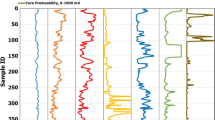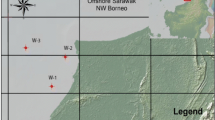Abstract
Permeability is an essential parameter for the reservoir characteristics, which controls the flowing fluids in the reservoir hence the sweep efficiency and the ultimate recovery. The common practice in the petroleum industry is coring a limited number of wells, due to the expensive core recovery process, and measuring the permeability in the recovered cores then extend the concluded correlation to the un-cored wells. However, establishing a reliable permeability predictor is not an easy task in many heterogeneous formations due to the spatial variability of the permeability even at very close distances. Therefore, the conventional linear regression has often failed to address the formation’s heterogeneity, and an unsatisfied correlation coefficient has frequently obtained. Lower Qamchuqa formation, which is highly prolific producing formation in the Middle East, has been used as an example of highly heterogeneous carbonate systems. Well log measurements, which are available for most of the wells, in addition to the core data, were used to capture the high heterogeneity of the depositional environment. Core-log depth calibration was first performed to extract the accurate log measurements that correspond to the actual core data depth. Then, both core and log data were listed in a table for the statistical analysis using the neural network (NN) and multivariate regression approaches. A remarkable improvement in the correlation coefficient was obtained using the NN approach. The utilised training data and further verified by the validation data set have obtained a favourable accuracy compared with conventional linear regression or multivariate regression. The NN permeability predictor has proven its ability to overcome the complexity of the carbonate rock textures and the variety of the diagenesis alteration processes, which make the NN approach a superior method in obtaining an improved permeability predictor. Nevertheless, a regular update to estimate the permeability predictor would be necessary when new data acquired.















Similar content being viewed by others
Data availability
A permission is required from the Ministry of Oil of Iraq to access the core data.
Abbreviations
- RQI:
-
Rock quality index
- k :
-
Permeability, mD
- φ z :
-
Normalised porosity
- φ e :
-
Effective porosity, fraction
- FZI:
-
Flow zone indicator
- DT:
-
Acoustic transit time
- GR:
-
Gamma-ray log
- LLD:
-
Lateral log deep
- LLS:
-
Lateral log shallow
- MSFL:
-
Micro-spherically focused log
- NPHI:
-
Neutron log derived porosity
- RHOB:
-
Bulk density
- SP:
-
Spontaneous potential
- TR:
-
Transformed (variable)
- N :
-
Normalised (variable)
- λ 0–λ 6 :
-
Constants
- C v :
-
Coefficient of variation
- SD:
-
Standard deviation
- k arith :
-
Arithmetic average of permeability
- λ :
-
Fracture-matrix permeability ratio
References
Abu-Shiekah IM, Warrlich GM, Goossens P, Alexander DM, Zhu F, Al-Lamki AA (2009) Shuaiba transition zone reservoirs: from modeling studies to field development challenges. SPE/EAGE Reserv Charact Simul Conf. https://doi.org/10.2118/125477-MS
Adler PM, Thovert J-F, Mourzenko VV (2013) Fractured porous media. Oxford University Press. https://doi.org/10.1093/acprof:oso/9780199666515.001.0001
Agada S, Geiger S, Doster F (2016) Wettability. Hysteresis and fracture-matrix interaction during Co2 EOR and storage in fractured carbonate reservoirs. Int J Greenh Gas Control. https://doi.org/10.1016/j.ijggc.2015.12.035
Aljuboori F, Corbett P, Bisdom K, Bertotti G, Geiger S (2015) Using outcrop data for geological well test modelling in fractured reservoirs. In: 77th EAGE conference and exhibition 2015: Earth science for energy and environment. https://doi.org/10.3997/2214-4609.201413037
Aljuboori FA, Lee JH, Elraies KA, Stephen KD (2019) Gravity drainage mechanism in naturally fractured carbonate reservoirs; review and application. Energies. https://doi.org/10.3390/en12193699
Aljuboori FA, Lee JH, Elraies KA, Stephen KD (2020a) Effect of fracture characteristics on history matching in the Qamchuqa reservoir: a case study from Iraq. Carbonates Evaporites 35:87. https://doi.org/10.1007/s13146-020-00607-3
Aljuboori FA, Lee JH, Elraies KA, Stephen KD (2020b) The effectiveness of low salinity waterflooding in naturally fractured reservoirs. J Pet Sci Eng 191:107167. https://doi.org/10.1016/j.petrol.2020.107167
Aljuboori FA, Lee JH, Elraies KA, Stephen KD (2020c) Using low salinity waterflooding to improve oil recovery in naturally fractured reservoirs. Appl Sci. https://doi.org/10.3390/app10124211
Amaefule JO, Altunbay M, Tiab D, Kersey DG, Keelan DK (1993) Enhanced reservoir description: using core and log data to identify hydraulic (flow) units and predict permeability in uncored intervals/wells. SPE Annu Tech Conf Exhib. https://doi.org/10.2118/26436-MS
Babadagli T, and Al-Salmi S (2002) Improvement of permeability prediction for carbonate reservoirs using well log data. Paper presented at the SPE Asia Pacific oil and gas conference and exhibition, Melbourne, Australia. https://doi.org/10.2118/77889-MS
Babadagli T, Al-Salmi S (2004) A review of permeability-prediction methods for carbonate reservoirs using well-log data. SPE Reserv Evalua Eng. https://doi.org/10.2118/87824-PA
Bagheri M, Rezaei H (2019) Reservoir rock permeability prediction using SVR based on radial basis function kernel. Carbonates Evaporites 34:699–707. https://doi.org/10.1007/s13146-019-00493-4
Barman I, Sharma AK, Walker RF, Gupta-Datta A (1998) Permeability predictions in carbonate reservoirs using optimal non-parametric. SPE/DOE Improv Oil Recover Symp. https://doi.org/10.2118/39667-MS
Beirami R, Riahi MA, Hosseini M (2017) An introduction to wireline log analysis by integration of ascendant hierarchical clustering and k-nearest neighbor methods for permeability prediction using conventional well logs and core data. Carbonates Evaporites 32:95–101. https://doi.org/10.1007/s13146-016-0313-6
Bust VK, Oletu JU, Worthington PF (2011) The challenges for carbonate petrophysics in petroleum resource estimation. SPE Reserv Eval Eng 14:25–34. https://doi.org/10.2118/142819-PA
Guo G, Diaz M, Paz F, Smalley J, Waninger E (2005) Rock typing as an effective tool for permeability and water-saturation modeling: a case study in a clastic reservoir in the Oriente Basin. SPE Annu Tech Conf Exhib. https://doi.org/10.2118/97033-MS
Guo G, Diaz MA, Paz FJ, Smalley J, Waninger EA (2007) Rock typing as an effective tool for permeability and water-saturation modeling: a case study in a clastic reservoir in the Oriente basin. SPE Ann Tech Conf Exhib. https://doi.org/10.2118/97033-PA
Jassim SZ, Buday T, Goff JC (2006) Geology of Iraq, 1st edn. Dolin, Prague and Moravian Museum, Brno
Jensen JL, Lake LW, Corbett PWM, Goggin DJ (2000) Statistics for petroleum engineers and geoscientists, 2nd edn. Elsevier Science Publishers, Netherlands
Kazemi H (1969) Pressure transient analysis of naturally fractured reservoirs with uniform fracture distribution. SPE-2156-B 9. https://doi.org/10.2118/2156-A
Lucia FJ (2007) Carbonate reservoir characterization, an integrated approach, 2nd edn. Springer, Berlin. https://doi.org/10.1007/978-3-540-72742-2
Maier C, Schmid KS, Ahmed M, Geiger S (2013) Multi-rate mass-transfer dual-porosity modelling using the exact analytical solution for spontaneous imbibition. SPE-164926-MS. https://doi.org/10.2118/164926-MS
Maslennikova Y (2013) Permeability prediction using hybrid neural network modelling. SPE Annu Tech Conf Exhib. https://doi.org/10.2118/167640-STU
Mohaghegh S (2000a) Virtual-intelligence applications in petroleum engineering: part 1—artificial neural networks. J Pet Technol 52:64–73
Mohaghegh S (2000b) Virtual-intelligence applications in petroleum engineering: part 3—fuzzy logic. J Pet Technol 52:82–87
Mohaghegh S, Arefi R, Ameri S, Rose D (1995) Design and development of an artificial neural network for estimation of formation permeability. SPE Comput Appl. https://doi.org/10.2118/28237-PA
Rahimi M, Riahi MA (2020) Static reservoir modeling using geostatistics method: a case study of the Sarvak Formation in an offshore oilfield. Carbonates Evaporites 35:62. https://doi.org/10.1007/s13146-020-00598-1
Sadooni FN (2018) Impact of the demise mechanisms of the Cretaceous rudist buildups in the Arabian Plate on their reservoir characteristics. Carbonates Evaporites 33:465–476. https://doi.org/10.1007/s13146-017-0355-4
Sahimi M (2011) Flow and transport in porous media and fractured rock: from classical methods to modern approaches, 2nd edn. Wiley-VCH Verlag GmbH & Co. KGaA. https://doi.org/10.1002/9783527636693
Shokir EM (2006) A novel model for permeability prediction in uncored wells. SPE Reserv Evaluat Eng. https://doi.org/10.2118/87038-PA
Soleimani B, Moradi M, Ghabeishavi A, Mousavi A (2019) Permeability variation modeling and reservoir heterogeneity of Bangestan carbonate sequence, Mansouri oilfield, SW Iran. Carbonates Evaporites 34:143–157. https://doi.org/10.1007/s13146-018-0461-y
Strecker U, Ibrahim MM (2017) Carbonate clinoforms, sinkholes, reefs, and flow units: integrated seismic reservoir characterization in shuaiba formation UAE. Abu Dhabi Int Pet Exhib Conf. https://doi.org/10.2118/188617-MS
Tiab D, Donaldson EC (2016) Chapter 8—naturally fractured reservoirs. In: Tiab D, Donaldson EC (eds) Petrophysics, 4th edn. Gulf Professional Publishing, Boston, pp 415–481. https://doi.org/10.1016/B978-0-12-803188-9.00008-5
Warren JE, Root PJ (1963) The behavior of naturally fractured reservoirs. SPE-426-PA-3. https://doi.org/10.2118/426-PA
Witherspoon PA, Wang JSY, Iwai K, Gale JE (1980) Validity of cubic law for fluid flow in a deformable rock fracture. Water Resour Res 16:1016–1024. https://doi.org/10.1029/WR016i006p01016
Xie J (2008) Improved permeability prediction using multivariate analysis methods. Master's thesis, Texas A&M University. Available electronically from https://hdl.handle.net/1969.1/ETD-TAMU-3223
Acknowledgements
The authors would like to express their deepest gratitude to Universiti Teknologi PETRONAS for providing the required software license and creating the necessary working environment. The authors would also like to thank the Ministry of Oil of Iraq and the management of North Oil Company for their permission to use their data in this work.
Author information
Authors and Affiliations
Corresponding author
Additional information
Publisher's Note
Springer Nature remains neutral with regard to jurisdictional claims in published maps and institutional affiliations.
Rights and permissions
About this article
Cite this article
Aljuboori, F.A., Lee, J.H., Elraies, K.A. et al. Using statistical approaches in permeability prediction in highly heterogeneous carbonate reservoirs. Carbonates Evaporites 36, 49 (2021). https://doi.org/10.1007/s13146-021-00707-8
Accepted:
Published:
DOI: https://doi.org/10.1007/s13146-021-00707-8




